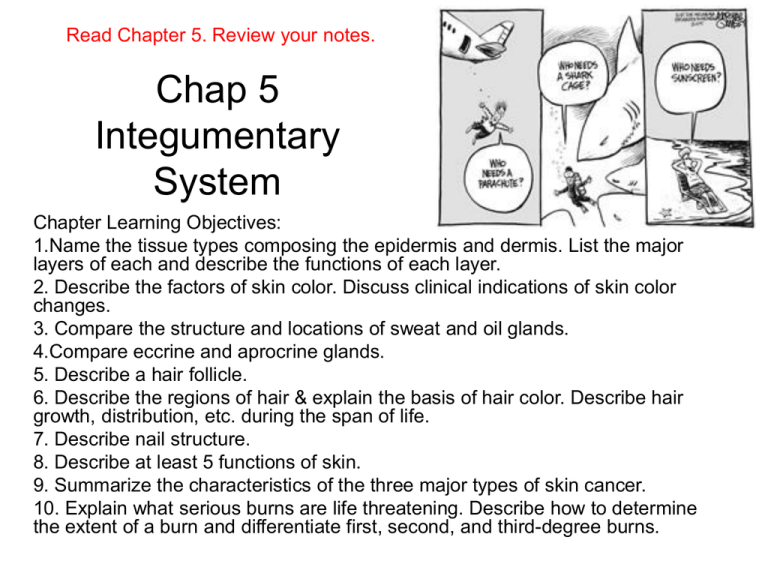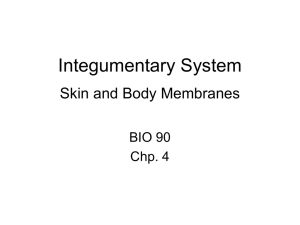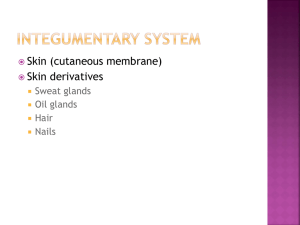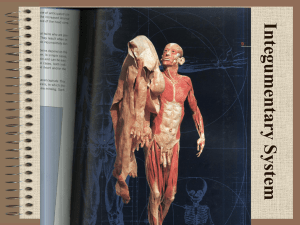Chapter 5 - Integumentary System
advertisement

Read Chapter 5. Review your notes. Chap 5 Integumentary System Chapter Learning Objectives: 1.Name the tissue types composing the epidermis and dermis. List the major layers of each and describe the functions of each layer. 2. Describe the factors of skin color. Discuss clinical indications of skin color changes. 3. Compare the structure and locations of sweat and oil glands. 4.Compare eccrine and aprocrine glands. 5. Describe a hair follicle. 6. Describe the regions of hair & explain the basis of hair color. Describe hair growth, distribution, etc. during the span of life. 7. Describe nail structure. 8. Describe at least 5 functions of skin. 9. Summarize the characteristics of the three major types of skin cancer. 10. Explain what serious burns are life threatening. Describe how to determine the extent of a burn and differentiate first, second, and third-degree burns. PREDICT Whose ______ is this? Predict And, whose _____ is this? Human Skin (Integument) • Our protective covering (considered to be an organ) – about as thick as a paper ________ • Weighs 9-11 lbs or ___% of total body weight • Has 3 distinct regions: a) ________ – outermost layer; no blood vessels b) ______ – fibrous connective tissue; has vessels c) __________ (superficial fascia) – deepest region Functions of the Integumentary • ________ – chemical, physical, and mechanical barrier • Body temperature _________ is accomplished by dilation (cooling) and constriction (warming) of dermal vessels and increasing sweat gland secretions to cool the body • Cutaneous _________ – exoreceptors sense ________ and _______ • Metabolic functions – synthesis of vitamin D in dermal blood vessels • ________ reservoir – skin blood vessels store up to 5% of the body’s blood volume • Excretion – limited amounts of nitrogenous wastes are eliminated from the body in sweat Skin (Integument) *Label your diagram Epidermis • Composed of __________ stratified squamous epithelium, consisting of four distinct cell types and four or five layers • Cell types include keratinocytes, melanocytes, Merkel cells, and Langerhans’ cells • Outer portion of the skin is exposed to the external environment and functions in protection Specialized Cells of the Epidermis • ___________ – produce the fibrous protein keratin • __________ – produce the brown pigment melanin • ___________ cells – epidermal macrophages that help activate the immune system • ______ cells – function as touch receptors in association with sensory nerve endings Layers of the Epidermis Stratum Basale • _________ epidermal layer firmly attached to the dermis • Consists of a single row of the youngest keratinocytes • Cells undergo _____ division Stratum Spinosum (_______ Layer) • Cells contain a web-like system of intermediate filaments attached to desmosomes • Melanin granules and Langerhans’ cells are abundant in this layer Stratum Granulosum (__________ Layer) • Thin; three to five cell layers in which drastic changes in keratinocyte appearance occurs • Keratohyaline and lamellated granules accumulate in the cells of this layer Stratum Lucidum (_______ Layer) • Thin, transparent band superficial to the stratum granulosum • Consists of a few rows of flat, dead keratinocytes • Present only in thick skin Stratum Corneum (_______ Layer) • Outermost layer of keratinized cells • Accounts for three quarters of the epidermal thickness • Functions include: – ______________ – Protection from _______ and ___________ – Rendering the body relatively insensitive to biological, chemical, and physical assaults Review of Epidermis 1. What are the 3 distinct regions of skin? 2. What is the name of the deepest epidermal layer? 3. What is the name of the outermost epidermal layer? Dermis • _______ major skin region containing strong, flexible connective tissue • Cell types include fibroblasts, macrophages, and occasionally mast cells and white blood cells • Composed of two layers: a) _________ (connective tissue with collagen and elastic fibers) b) ________ (collagen fibers add strength and resiliency to the skin; elastin fibers provide stretch-recoil properties) Hypodermis • Subcutaneous layer ______ to the skin • Composed of ______ (fat) and areolar connective tissue Skin Pigments – ________ – yellow to reddish-brown to black pigment, responsible for dark skin colors • Freckles and pigmented moles – result from local accumulations of melanin – ________ – yellow to orange pigment, most obvious in the palms and soles of the feet – __________ – reddish pigment responsible for the pinkish hue of the skin Pigment Disorders Instructions: With a partner, quickly pair and discuss the 5 pigment disorders found in the Homeostatic Imbalance section on page 143. Estimated Time: 2-3 minutes Appendages of the Skin • • • • • N_________ S______ glands O___ glands H_____ H____ f________ Nails __________ modification of the epidermis on the distal, dorsal surface of fingers and toes Sweat Glands • Different types prevent overheating of the body; secrete ________ and milk – _______ sweat glands – found in palms, soles of the feet, and forehead – _________ sweat glands – found in axillary and anogenital areas – Ceruminous glands – modified apocrine glands in external ___ canal that secrete cerumen (wax) – ________ glands – specialized sweat glands that secrete milk Sebaceous (Oil) Glands • Simple alveolar glands found all over the _______ • ______ skin when stimulated by hormones • Secrete an oily secretion called _______ Hair • Filamentous strands of dead keratinized cells produced by hair follicles • Contains hard keratin which is tougher and more durable than soft keratin of the skin • Pigmented by ____________ at the base of the hair • Hair is distributed over the entire skin surface except palms, soles, lips, and portions of external genitalia Hair – 3 Layers http://www.kidshealth.org/parent/general/bod y_basics/skin_hair_nails.html Functions of Hair • Functions of hair include: – Helping to maintain ________ – Alerting the body to presence of _______ on the skin – Guarding the scalp against physical ______, ____ loss, and sunlight Hair Follicle • Root sheath extending from the epidermal surface into the dermis • Deep end is expanded forming a hair ____ • A knot of sensory nerve endings (a root hair plexus) wraps around each hair bulb • Bending a hair stimulates these endings, hence our hairs act as sensitive _______ receptors Hair Follicle Anatomy Types of Hair • _______ – pale, fine body hair found in children and the adult female • _______ – coarse, long hair of eyebrows, scalp, axillary, and pubic regions Skin Cancers • The three major types of skin cancer are: – ______ cell carcinoma – ________ cell carcinoma – __________ Can you spot a suspicious skin area? Basal Cell Carcinoma • _______ malignant and most common skin cancer • Stratum basale cells proliferate and invade the dermis and hypodermis • Slow growing and do not often metastasize • Can be cured by surgical excision in 99% of the cases Squamous Cell Carcinoma • Arises from keratinocytes of stratum spinosum • Arise most often on scalp, ears, and lower lip • Grows ________ and metastasizes if not removed • Prognosis is good if treated by radiation therapy or removed surgically Melanoma Cancer of melanocytes is the most ______________ type of skin cancer because it is: - Highly metastatic - Resistant to chemotherapy Melanomas have the following characteristics (ABCD rule) – A: __________; the two sides of the pigmented area do not match – B: ______ is irregular and exhibits indentations – C: ______ (pigmented area) is black, brown, tan, and sometimes red or blue – D: ________ is larger than 6 mm (size of a pencil eraser) Burns • ______-degree – only the epidermis is damaged – Symptoms include localized redness, swelling, and pain • _______-degree – epidermis and upper regions of dermis are damaged – Symptoms mimic first degree burns, but blisters also appear • ______-degree – entire thickness of the skin is damaged – Burned area appears gray-white, cherry red, or black; there is no initial edema or pain (since nerve endings are destroyed) Rule of Nines • Estimates the severity of burns • Burns considered critical if: – Over __ % of the body has seconddegree burns – Over __ % of the body has thirddegree burns – There are thirddegree burns on face, hands, or feet










